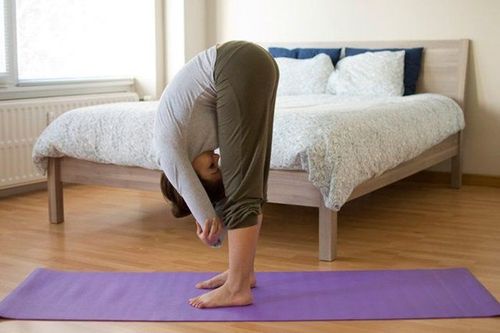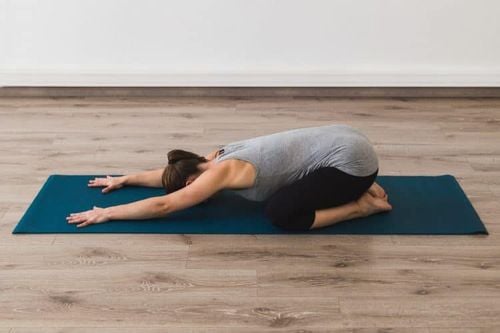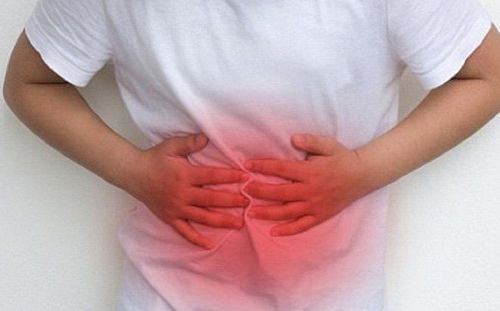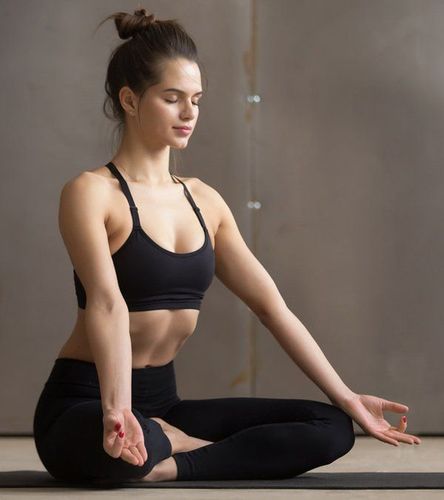This is an automatically translated article.
Insomnia occurs mainly in adults and seriously affects the quality of your sleep. How can relaxation exercises before bed help you? Learn about a few relaxation techniques before bed to ease sleep problems.
1. What is trouble sleeping?
Difficulty falling asleep is a common condition. Studies show that nearly a third of adults suffer from chronic insomnia, a sleep disorder characterized by persistent difficulties falling asleep. Difficulty falling asleep can also occur in people who do not have insomnia that makes them toss in bed after a stressful day, having difficulty falling asleep.
A state of anxiety, worry or stress that causes sleep problems. During times of stress, the body triggers its natural stress response, the production of a flood of hormones that make you feel more alert and trigger additional physiological changes. Breathing becomes faster and shallower with an increase in heart rate and blood pressure. Besides, the digestive system will slow down.
When the body's stress response is activated, falling asleep can be extremely difficult. Fortunately, researchers have shown that there is a way we can turn off the stress response by activating another natural process, known as the relaxation response. This mechanism helps to calm the mind, relax the body and help you drift off to sleep naturally.
2. Relaxation exercises to help fall asleep
There are many exercises to activate the body's relaxation response. What these exercises have in common is to help lower heart rate and blood pressure, and to slow and deepen breathing. It also creates an increased sense of well-being. These changes can help us fall asleep more easily. Before you try relaxation exercises to help you fall asleep, here are some helpful tips to keep in mind.
These relaxation exercises are useful tools to help you fall asleep more easily, but they can be more effective when combined with maintaining a consistent sleep schedule and building a sleep-promoting daytime routine. Practice relaxation exercises regularly to get better results than just doing them once or for a short time. Choose relaxation techniques that work for you. You can try many different exercises, if it doesn't work, try another relaxation exercise that helps you fall asleep. If possible, consult your doctor before performing relaxation techniques. This is especially important for people with epilepsy, mental illness, or a history of trauma.

Tập yoga thư giãn trước khi ngủ
2.1 Breathing exercises
Breathing exercises are one of the most basic exercises that engage the natural relaxation response of the muscles. Do this exercise by breathing slowly and deeply. If you find it difficult to fall asleep, take about 10 deep breaths. This can begin to slow breathing and create a feeling of calm. If you find this relaxation exercise before bed doesn't work for you, try a few other exercises.
Diaphragm breathing
Diaphragm breathing (also called abdominal breathing) uses the large muscles at the base of the lungs. This exercise can not only relieve stress and increase relaxation for easy sleep, but it can also strengthen the diaphragm and increase breathing efficiency. Here's how to breathe through the diaphragm:
While lying down, place one hand on your upper chest and the other on your belly, just below your rib cage. Your hands will help ensure that you only breathe through your belly during this exercise. Inhale through your nose so that your belly pushes into your hands. The other hand and chest should remain still as much as possible. While continuing to keep your chest still, squeeze your abs and exhale by pursed lips (the way you might hold your lips while whistling). Repeat this process. Because many of us are not used to moving our diaphragm while breathing, this exercise can take a while to get used to. Try starting with just a few minutes of diaphragmatic breathing in bed, then gradually increase the time for maximum effect.
4-7-8 breathing
This advanced breathing technique helps control your breathing rate. While doing this technique you may feel uncomfortable holding your breath, but it is considered safe and easy to do for relaxation and sleep. Here's how to do this technique.
Place the tip of your tongue on the roof of your mouth, just behind the front teeth (keep it here for the entire exercise). Inhale through your nose for 4 seconds. Hold your breath for 7 seconds. Exhale through your mouth for 8 seconds, you exhale making a natural sound. As with other breathing exercises, start by practicing this technique for a few minutes before bed. Once you get used to the tempo, increase the duration of the 4-7-8 breathing exercises to suit you.
2.2 Visualization exercises
Visualization exercises are another exercise to engage in natural relaxation of the body.. These techniques are based on the use of mental imagery to create a feeling of well-being in the body, can do Reduce stress and help you relax easily fall asleep.
Body scan
Body scan is a type of meditation that focuses slowly on parts of the body. Once you're comfortable in bed, try these steps for a body scan::
First start by taking a few deep breaths, maybe try diaphragmatic breathing or 4-7-8 to bring your muscles in. can enter a state of relaxation. Focus your attention on your feet, notice any sensations in your toes, and if you are holding any tension in this part of your body. If you find discomfort here, acknowledge it and try to let go of any thoughts about the stories you have. Visualize the tension leaving your body through your breath. When you're ready, shift the focus to your calf muscles, repeat the process of noting the sensation, letting go of the thought or story, and visualizing the tension through your breath. Move your attention to each part of your body, moving from your feet to your forehead until you have scanned your entire body. Autogenous Training
Autogenic Training takes you through the same steps as a body scan, but adds your own judgments about how heavy and warm each part of the body is. The idea is that, with practice, you can start soothing different parts of your body at any time. Here's how to do this exercise:
Start with a few minutes of breathing exercises to get into a relaxed state. Next, focus your attention on your feet, then slowly repeat six times, "my legs are heavy, I'm completely calm." Re-focus on your feet, then slowly repeat 6 more times, "my feet are warm, I'm completely calm." Repeat this process as you shift your attention to each part of your body, from your feet to your head, repeating each phrase about weight and warmth. If you find it too distracting to remember each phrase or count how many times you've said them, you can record the process and play it back before bed. You can also find audio and video recordings online to guide you through this exercise.

Tập yoga thư giãn trước khi ngủ giúp bạn ngủn ngon hơn
2.3 Progressive muscle relaxation
When the muscles are relaxed, it is difficult to tense, this is the idea of progressive muscle relaxation techniques. This exercise is performed by methodically stretching and relaxing 16 different muscle groups.
First, write down all the muscle groups or record yourself saying, giving about 45 seconds between each group so you have enough time to do this process. Muscle groups include: hands, wrists and forearms, biceps, shoulders, forehead, around eyes and nose, cheeks and jaw, around mouth, back of neck, front of neck, chest, back, abdomen, hips and buttocks, thighs and legs. When you're ready, lie down on the bed and try the technique:
Inhale and stretch the first muscle group for 5-10 seconds. Exhale and quickly relax the muscles in that group. Stay relaxed for 10-20 seconds before moving on to the next muscle group. Repeat this process until you have worked all 16 muscle groups. Once you're done, focus on keeping all muscle groups relaxed as you drift off to sleep.
Self-hypnosis
Self-hypnosis is similar to progressive muscle relaxation, with the added addition of focusing on a specific thought when you are fully relaxed. Some people focus on a simple word, like "relax" or "let go," while others may repeat a phrase like "I am relaxed and calm." You can also record yourself saying these phrases and simply listen to them while you are performing progressive muscle relaxation. There are also online videos with pre-recorded phrases for falling asleep. Once you've decided on your phrase, take the following steps:
Lie on the bed in a comfortable position. Transition to a hypnotic state with a brief period of progressive muscle relaxation, tension and relaxation of various muscles in the body. Once completely relaxed, slowly repeat your favorite phrase. Once you've mastered self-hypnosis, try adding other senses to your thinking. Imagine you are in a safe place or a dreamy place, now add the activity of senses such as smell and relaxing bodily sensations around you. A common scenario is to imagine you are on a prairie, green meadow, with a field of flowers, smelling lavender and feeling the warm sunlight on your skin.
2.4 Biofeedback
This technique uses electronic devices to help the user monitor internal body processes such as brain waves, heart rate, breathing rate and body temperature. If you're interested in trying biofeedback, you can talk to your doctor or sleep specialist about the tools they have available. For a simpler start, you can also try using a wearable device, like a smartwatch, chest strap, or fitness tracker.
Test the device at different times of the day to learn about what affects your heart rate, blood pressure and breathing rate. Once you have a grasp of what affects these processes, start experimenting with what you can do to affect them. Develop your own strategies to lower your blood pressure and heart rate, slow your breathing, and increase your overall sense of well-being. This will help you relax and fall asleep easier.
Above are some very useful relaxation exercises before bed that you can refer to. If the above exercises do not improve your sleep problems, see your doctor for timely treatment.
Please dial HOTLINE for more information or register for an appointment HERE. Download MyVinmec app to make appointments faster and to manage your bookings easily.
Reference source: webmd, verywellhealth













